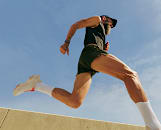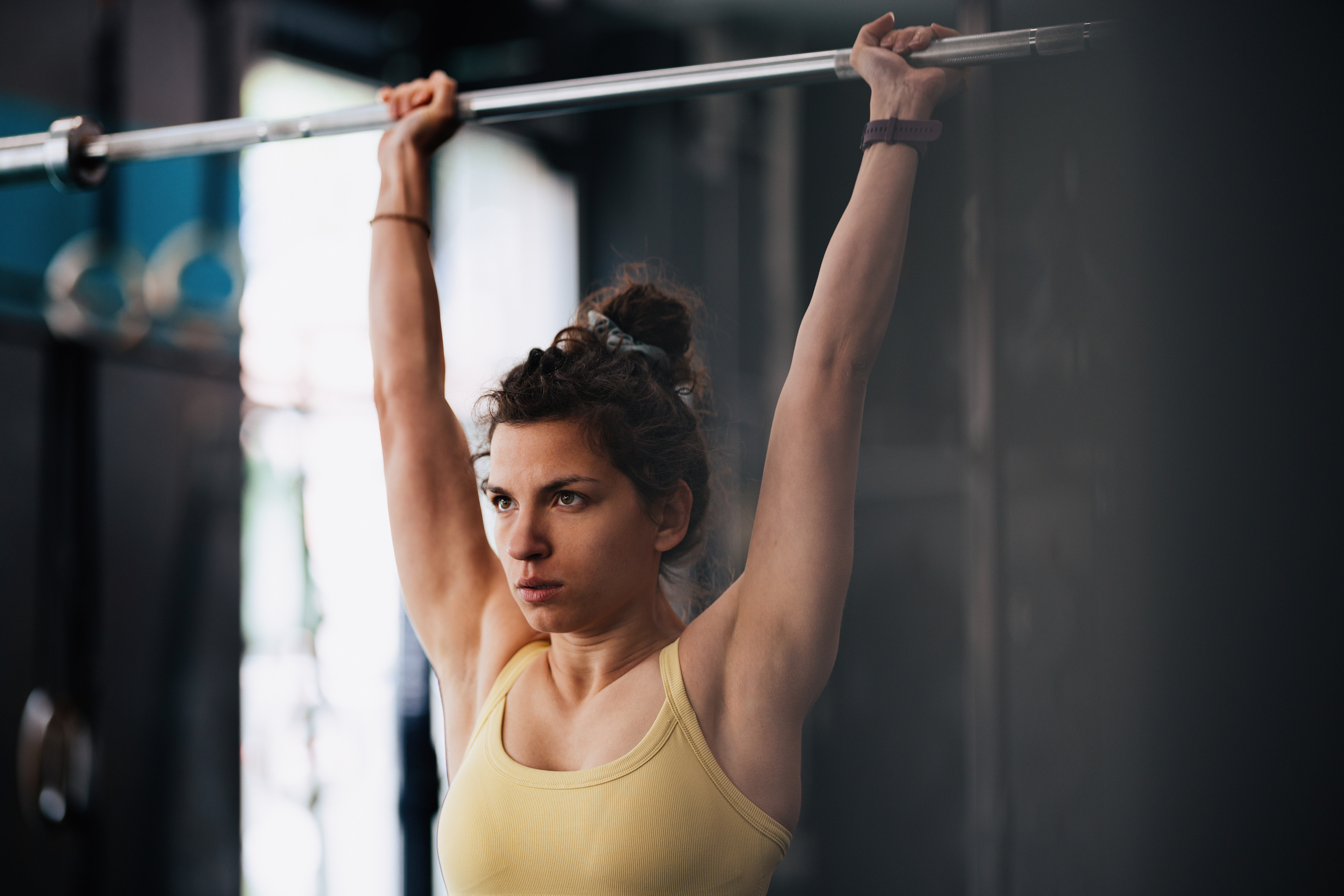
Miniseries via Getty Images
The Overhead Press Is a Functional Strength Superstar. Here’s How to Master It
It’s time to raise the bar.
By Emily Laurence•
What Is an Overhead Press?
Muscles Worked By Overhead Presses
How to Do a Barbell Overhead Press Correctly
Tips to Keep In Mind for Barbell Overhead Presses
Overhead Press Variations
Mistakes to Avoid When Doing Overhead Presses
When it comes to strength training, many people’s first stop is the dumbbell rack. There’s no shortage of moves you can do with a pair of weights—and it can be less intimidating than trying to figure out the machines. But once you’ve built a solid base of strength, if you really want to challenge your upper body, it may be time to try the barbell overhead press.
Discover more ways to reach your goals with Peloton
The key to mastering the overhead press is knowing how much weight you should put on the barbell and the steps for doing the move with proper form. Consider this your guide to everything you need to know, including overhead press modifications and mistakes to avoid.
What Is an Overhead Press?
An overhead press, also known as a shoulder press, is a resistance training exercise that involves pressing a weight from shoulder height directly overhead. It can be done using a barbell, dumbbells, kettlebells, or resistance bands, though we’re focusing on the barbell variation here.
“The barbell overhead press has several benefits: strength and stability of the shoulders; building strength and power for the upper body; and stability, strength, and balance for the core,” says Peloton instructor Marcel Maurer.
The overhead press is a functional strength move, meaning the skills and strength you build with this exercise can carry over to everyday activities, such as lifting your suitcase to stuff it in the overhead bin, reaching for high shelves, or carrying kids. This move strengthens the shoulders and core while reinforcing overall stability, which is key for longevity in movement and injury prevention.

Peloton App
Access thousands of classes with no equipment needed.
Muscles Worked By Overhead Presses
The whole upper body gets in on the action with an overhead press, as well as your core and glutes. Here are the specific muscles worked by a barbell overhead press, according to Marcel:
Deltoids: Your deltoids are a group of triangle-shaped muscles located in the rounded part of the shoulders. Marcel says this is one of the primary muscle groups targeted by the overhead press, and is why this move is also referred to as a shoulder press.
Triceps: The triceps are located on the back of the upper arm, and are another one of the primary muscles involved in an overhead shoulder press, Marcel says. The triceps work to straighten your elbow, which helps execute moves like triceps dips and triceps kickbacks, as well as the overhead press.
Upper Chest: The overhead press also indirectly works the upper part of your pectoral (i.e., chest) muscles. These muscles help to keep the upper body stable and push the bar upward.
Trapezius: The trapezius muscles are another secondary muscle group used while doing an overhead press. Located over the back of the neck and shoulders, these muscles also help stabilize the shoulders while you press the weight overhead.
Core: While you’re pressing the weight overhead, your core is working to keep your torso strong and stable. This includes deep core muscles, like the transverse abdominis, as well as the muscles in your back (which are part of your core too).
Glutes: Lastly, the glutes, the large muscles of the buttocks, also aid in stabilizing the body during each overhead press rep.
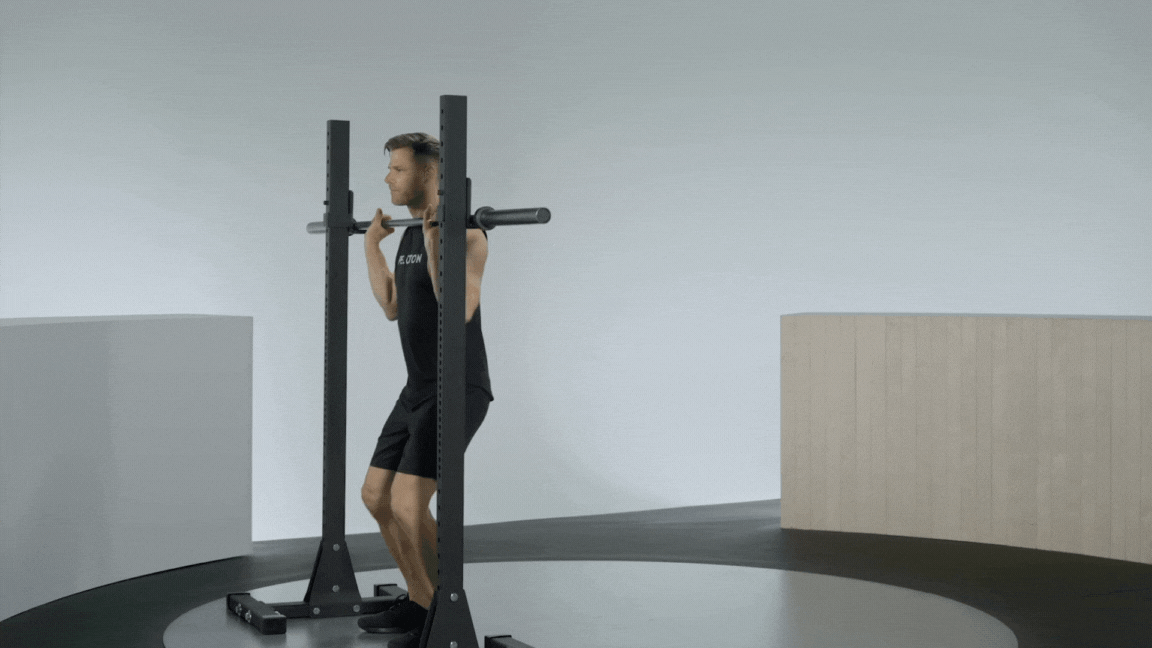
How to Do a Barbell Overhead Press Correctly
When doing overhead presses, it’s important to maintain proper form—especially when you’re lifting something large and heavy, like a loaded barbell. It’s key for protecting the body from injury and reaping the maximum benefits from the move.
That said, before you pick up a barbell, it’s a good idea to learn how to do the overhead press using the steps below without any weights—you can even use a broomstick or PVC pipe to get the form down first. To try it with weight, start with smaller free weights, like dumbbells, as described below.
Finally, when you’re ready to try barbell overhead presses, do them first with an unloaded barbell (which typically weighs 33 to 45 pounds, depending on the exact type) and progress slowly from there. “Pay attention to the right technique first and then increase gradually,” Marcel says. As a general rule of thumb, if you’ve chosen the right weight, you should feel the work from the very first rep and start to struggle during the last few reps. If you breeze through each set without tiring, your weight is probably too light; if you have trouble maintaining proper form until the last few reps, it’s probably too heavy.
Ready to give it a try? Here’s how to do a barbell overhead press, step by step, according to Marcel.
Place an unloaded barbell in a squat rack, racked at a position just lower than shoulder height. Step under the bar with your feet hip-width apart, knees bent, and core engaged. Grab the bar with your hands slightly wider than shoulder-width apart, with an overhand grip (your palms facing away from you).
Straighten your knees to lift the bar off the rack, holding it just above your collarbones, your elbows slightly in front of the bar. Carefully take two controlled steps backward so there’s space between you and the squat rack. Stand with your feet hip-width distance apart, your knees softly bent, and your glutes and core engaged. This is your starting position.
Inhale, then exhale to press the bar over your head without momentum. To do this, move your head backward (tucking your chin toward your neck, creating a double chin) to create enough space for the bar to travel upward in a straight line. As soon as the bar has passed your forehead, move your head forward again and extend your arms overhead at the same time, so the bar is directly over your shoulders. At the top of the movement, keep your core engaged and avoid arching your back.
Reverse the movement to lower the bar with control and return to the starting position. That’s one rep.
Tips to Keep In Mind for Barbell Overhead Presses
It bears repeating that proper form is crucial when doing an overhead press, so it’s best to practice it without any weights first.
Before you attempt the move, it’s also essential that you have good mobility in your thoracic spine and shoulders, Marcel says. If you’re lacking back and shoulder mobility, it’ll be difficult to maintain proper form and could lead to injury. If you feel stiff, warm up with some shoulder mobility exercises first, or take an upper body strength warm-up or mobility class on the Peloton App.
When doing an overhead press, Marcel says to keep your feet parallel and hip-width apart. This will help keep you balanced and stable. Keep your wrists in a neutral position, not bent backward or forward, but straight and in line with your forearms, gripping the barbell tightly.
Don’t discount the importance of your breath, either. Marcel recommends inhaling while in the starting position, then exhaling as you press the barbell overhead.
Overhead Press Variations
If a barbell overhead press feels out of reach for you right now, there are plenty of ways to modify it.
Single Dumbbell Overhead Press
One variation Marcel recommends is using a single dumbbell instead of a barbell. “[Using a dumbbell to do an overhead press] allows you to internalize the movement sequence and work on breathing correctly,” Marcel says.
To do an overhead press with a single dumbbell, hold it horizontally in both hands, with one hand on either side of the weight, he says. Start with the dumbbell at shoulder height in front of your chest. Just like when using a barbell, press the dumbbell straight overhead without arching your back, keeping your core engaged to stabilize the body. Then, lower the dumbbell back to the starting position.
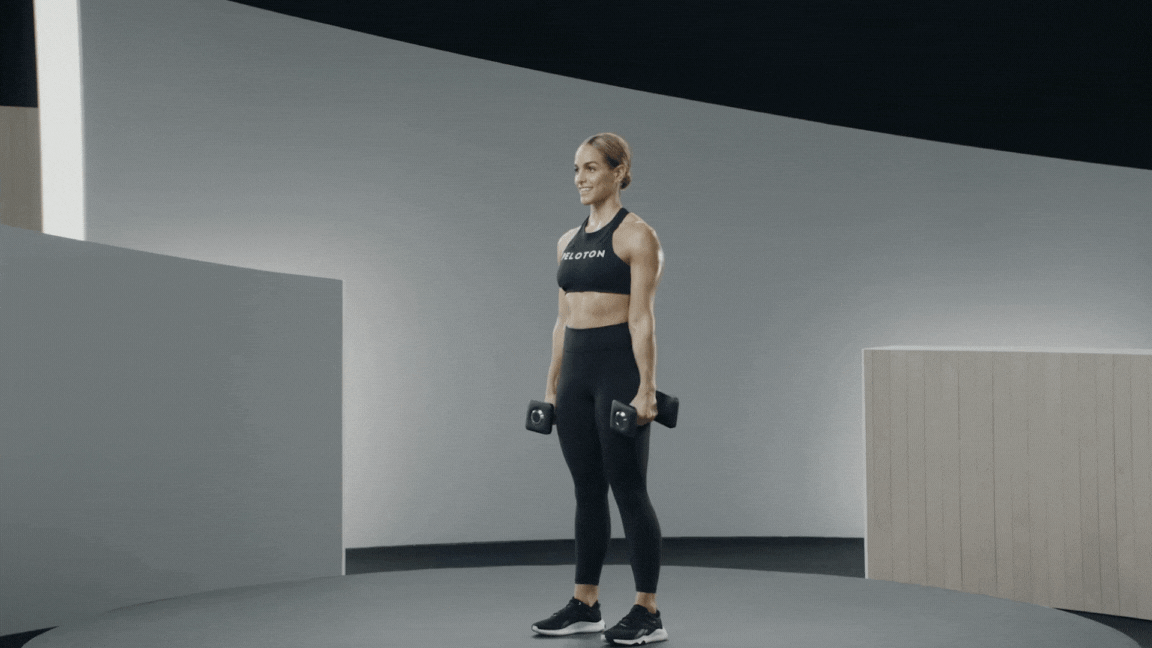
Dumbbell Overhead Press
Often referred to as a shoulder press, you can do an overhead press using two dumbbells, one in each hand. Rack the weights at shoulder height with your palms facing forward and your elbows wide. Then, press the dumbbells overhead, fully extending your arms with your biceps by your ears. If this position is uncomfortable for your shoulders, you can perform the press with your palms facing in toward each other, elbows in tight to your sides.
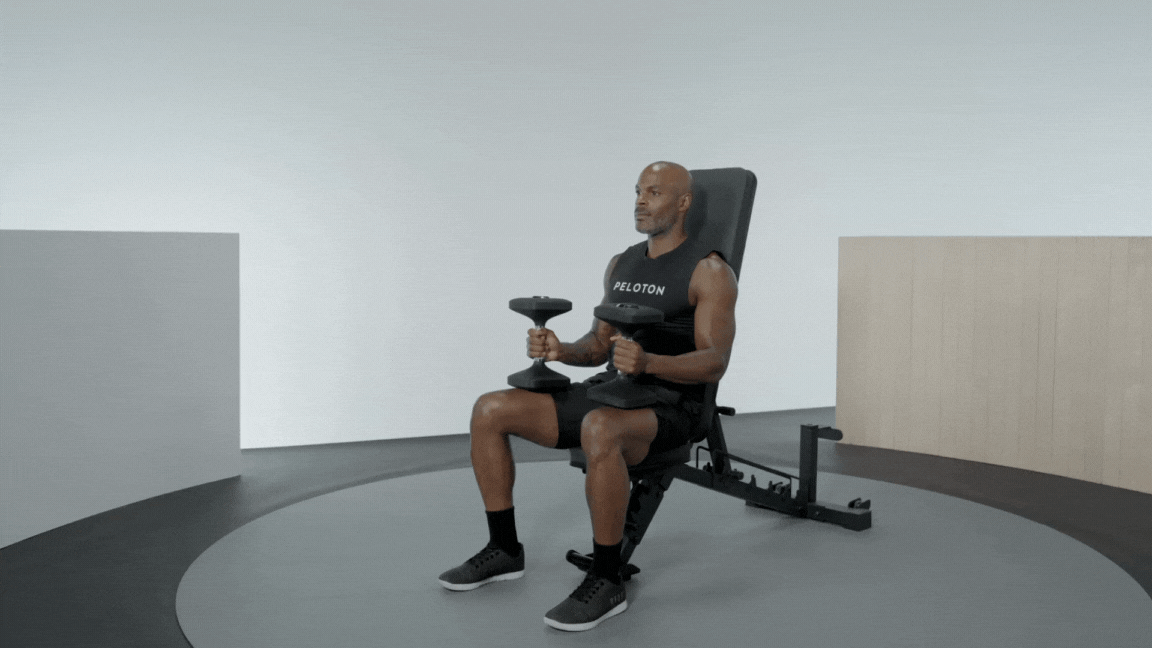
Seated Overhead Press
If you want an overhead press variation that provides more support for your back, you can modify the move by doing it in a seated position on an adjustable bench (with the back set at about 90 degrees) using a barbell or dumbbells.
Landmine Press
If you have shoulder mobility concerns, a landmine press is a great alternative to a barbell overhead press. This exercise is done one arm at a time using a landmine attachment, which allows you to anchor one end of the barbell to the floor or wall.
To do a landmine press, place one end of the barbell in the landmine attachment, and load the other end with any weights. Pick up the end of the barbell with the weight, bringing it up to shoulder height. Just like with a barbell overhead press, your feet should be hip-width distance apart, knees softly bent. Inhale, engage your core, and press the bar upward, fully extending the arm. Then, lower the weight back to the starting position. Perform as many reps as you’d like and then repeat with the other arm.
Mistakes to Avoid When Doing Overhead Presses
As you work on mastering the overhead press, keep these mistakes in mind and do what you can to avoid them.
Don’t go too heavy. One of the biggest mistakes Marcel says people make when doing an overhead press is putting too much weight on the barbell. Remember: It’s better to focus on nailing the technique first and increasing weight slowly than loading up the barbell from the get-go.
Don’t forget about your lower body. It’s important to maintain the proper stance so you have a strong base to lift from, Marcel says. That means standing with your feet hip-width distance apart, core engaged, and avoiding arching your back when you lift. Think about drawing the bottoms of your ribs and the tops of your hip bones together to activate your core. “And avoid leaning too far back,” Marcel adds.
Don’t let your grip lax. When you hold the bar, avoid gripping it too loosely; you don’t want to lose control of the barbell when it’s hovering over your head.
Don’t hold your breath. Last but not least, Marcel says to remember to breathe. You want to inhale before pressing and exhale as you push up.
Now that you know exactly how to do an overhead press, it should be less intimidating—but if you still want more guidance on how to do a barbell workout or build a strength training routine for the gym, consider the Peloton Strength+ app, which has a Workout Generator and instructor-led programs that make it easy to get started. Just don’t forget to move through some upper body stretches afterward as a way to cool down after all that hard work.
Related Articles

Stretching + Mobility
Melt Away Upper Body Tension with the Thread the Needle Stretch

Strength Train
The Dumbbell Row Never Gets Old with These 7 Variations

Strength Train
4 Signs You Have a Muscle Imbalance—And Exactly How to Fix It

Strength Train
Why Isolation Exercises Should Play a Supporting Role In Your Strength Routine
This content is for informational and educational purposes only and does not constitute individualized advice. It is not intended to replace professional medical evaluation, diagnosis, or treatment. Seek the advice of your physician for questions you may have regarding your health or a medical condition. If you are having a medical emergency, call your physician or 911 immediately.
Build full-body strength
Enter your email to get articles, instructor tips, and updates from Peloton sent to your inbox.
By providing your email address, you agree to receive marketing communications from Peloton.
For more about how we use your information, see our Privacy Policy.

